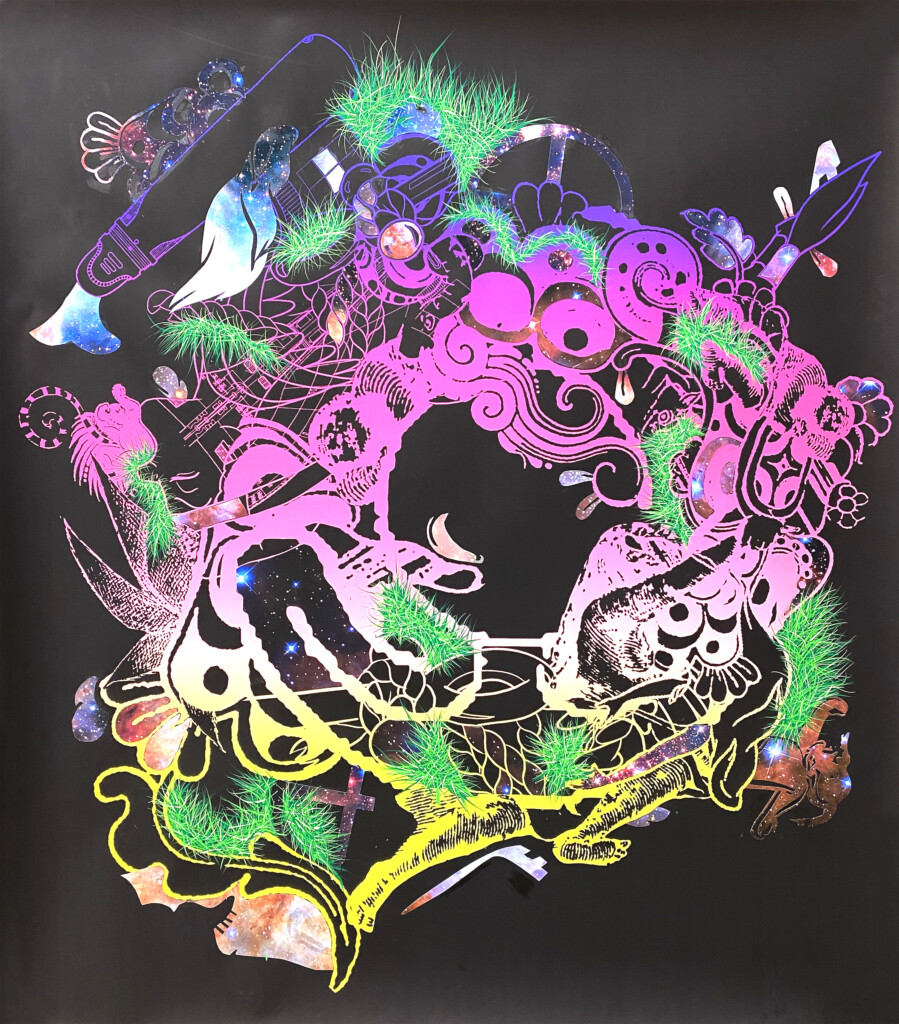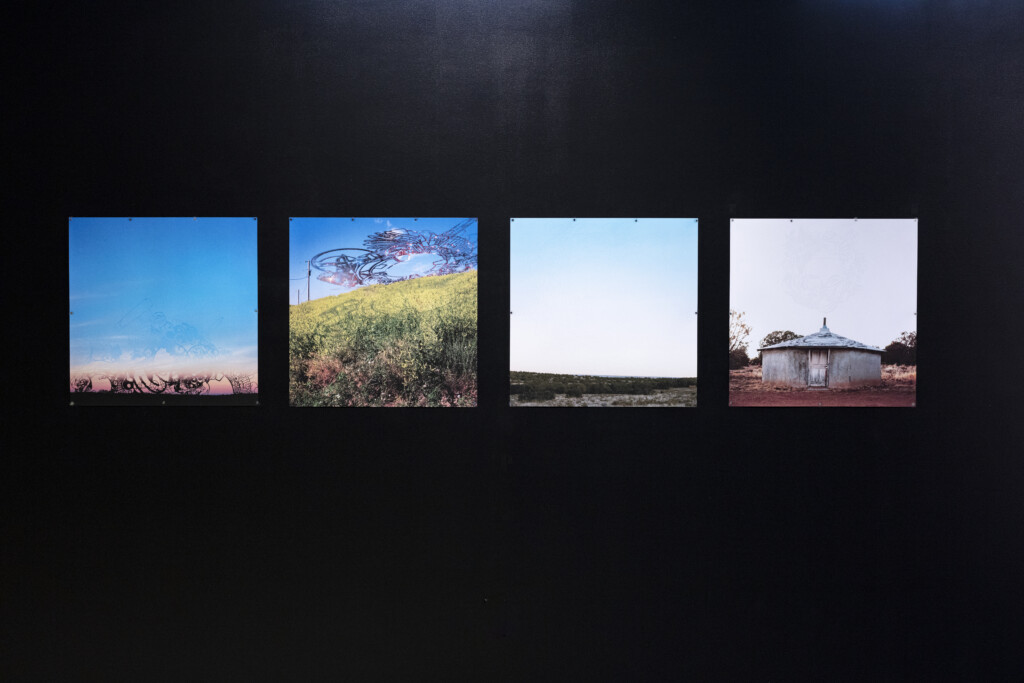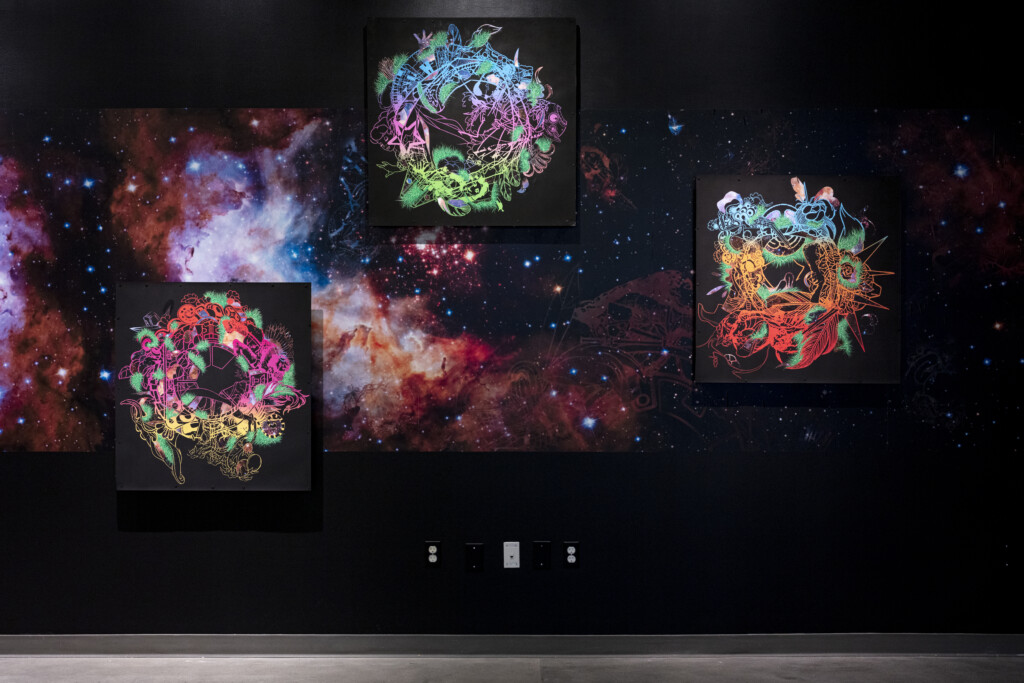Denae Shanidiin recalls the epiphany of spiritual healing she experienced during an Indigenous ceremony when she prayed and looked into the sacred fire. In her first glance, the Diné and Korean artist remembered what she had been told, that the initial look emphasized the darkness, sickness and individual vulnerability. But then after another round, the coal embers became shiny and bright, amplifying the spiritual meaning of the eternal sacred nature of home, because the spirit of whomever was living there is still present.
Shaniidin spoke last month at a panel discussion before the opening of Transcending Time and Space, a remarkable ACME Lab exhibition at the Utah Museum of Fine Arts. It features her writing and work in a uniquely synthesized public art installation created by David Rios Ferreira. The show David Rios Ferreira: Transcending Time and Space, featuring work and writing by artist Denae Shanidiin opened last month and continues through Dec. 4.

Among the First Nation issues Shanidiin has been working on is that of violence and, more specifically, cases of missing and murdered Indigenous peoples. One of the victims was Priscilla, her auntie.
“Prayer is an action,” she said, explaining the powers of prayers that her grandparents and the generations before them learned and applied in the old ways of ceremonial medicine that have been sustained for centuries. The concepts of reciprocity, kinship, the pristine beauty of water and ground, restoration and healing always have been embedded in the broader Indigenous wisdom that anchors the essential belief in faith and its capacity to heal one’s body.
There is an exceptional multidisciplinary impact in the meticulous synthesis of Shaniidin’s work with that of Ferreira, whose works emanate from themes, tropes, philosophies and ideals that come from science fiction, pop music, and the foundations of atmospheric memory and digital expression. There also are opportunities for community visitors to interact with and share their own experiences of love, loss and memory. The show complements the mission of Restoring Ancestral Winds, a Tribal coalition responding to the violence perpetrated on Indigenous communities within the Great Basin and strengthening the traditional values of Indigenous relations.

At first sight in taking the whole layout of the ACME Lab exhibit before examining each work in the show, it is worth contemplating an 1837 quote by Charles Babbage, among the earliest thinkers in the foundations of computation development. Consistently prescient in his work, he wrote in his Ninth Bridgewater Treatise a sentence that is moored with elegant cohesion in every element of this show: “The air itself is one vast library on whose pages are forever written all that man has ever said or woman whispered.”
The instincts that Ferreira and Shanidiin express in their work are, indeed, much older but undeniably both artists have carried in their bodies throughout their lives. These centuries-old instincts precisely embody what Babbage communicated and what many artists, writers, musicians, filmmakers and others subconsciously turn to in creating work that builds upon the ideals of atmospheric memory and makes these philosophical considerations tangible and edifying for us.
Ferreira, a Bronx-based artist who is mainland Puerto Rican, considered organizing the show less in a traditional gallery framework than as an organic public art event. His works are characterized as a hybrid of representation and abstract, where he deconstructs and then reconstructs images and their cultural and sociopolitcal tropes. Circles become portals or gateways and the works deftly transcend the two-dimensional limitations. The depth and breadth of imagery ensconced in each of these circle masterpieces result in astonishing compositions that harmonize disparate threads of the imagery, colors and textures into an ethereal cosmic feeling that sometimes points toward spiritual ecstasy.
The symbolic significance of circles sharpens the thematic cohesion throughout the show. History, memory and the legacy of identity are carried continuously and eternally in our blood and bodies, as both artists believe. Virtually every culture in human civilization history has attached predominant meaning to their respective integration of the circle’s symbolism. As Ferreira notes, “circles suggest many things: among them, talk circles, healing circles, hoops, medallions, stargates, and black holes.”

The symbiosis of both artists is evident when one considers science fiction. Among numerous inspirational sources to cite is the 2014 science fiction film Interstellar, directed by Christopher Nolan, and, specifically, the character of Dr. Amelia Brand, a NASA scientist and astronaut (which actor Anne Hathaway portrayed). Ferreira’s creative vision magnifies one key exchange in the film. Brand explains to a colleague that love is not an imagined invention of the human mind but that it is as valid as any scientific construct or hypothesis. “It’s… observable, powerful. It has to mean something,” she says. While her colleague acknowledges that love can have meaning as a social utility, Brand asks him then where is the social utility in loving those who have died. She adds, “Maybe it means something more – something we can’t yet understand. Maybe it’s some evidence, some artifact of a higher dimension that we can’t consciously perceive. I’m drawn across the universe to someone I haven’t seen in a decade, who I know is probably dead. Love is the one thing we’re capable of perceiving that transcends dimensions of time and space. Maybe we should trust that, even if we can’t understand it.”
As Ferreira considered the memories of murdered and missing Indigenous women and girls in planning the show, he also contemplated the 2001 murder of Fred “Frederica” C. Martinez, Jr., who was a 16-year-old two-spirit Navajo teen in Cortez, Colorado who went missing after attending the Ute Mountain Roundup Rodeo. Unlike the 1998 murder of Matthew Shepard in Laramie, Wyoming, which drew national attention, the death of Martinez was slow to draw attention from even the police. Finally, 10 days after the teen disappear did police finally respond to the family’s reports of Martinez as a missing person. The details of Martinez’s murder were just as gruesome as those Shepard had suffered. Martinez’s story would become part of a 2009 PBS documentary Two Spirits. The young Martinez considered pop singer Beyoncé as their spiritual muse and visitors familiar with her music will take note that the title of each of Ferreira’s circle works comes from a lyric of a Beyoncé song.

Ferreira works with historical etchings, old political cartoons, coloring books and films. But, as he restores them, his reconstructions — accomplished variously through layering, tracing and collage — reclaim and transform the original intentions and meanings of those images. Both artists during the public talk acknowledged that there are hopeful signs of progress as people become more aware of abuses that many have tried to hide and rationalize for decades. In recent years, the shameful scandals of the Indigenous boarding schools, which forced Tribal children to become Americanized and have their culture erased, have come to new light. Last summer, Utah tribal leaders and state history experts announced that the bodies of Paiute children were likely buried below the summer grass fields, which once housed an Indigenous boarding school they were forced to attend in Panguitch.
Ferreira noted that similar boarding schools were opened for similar purposes with children in Puerto Rico. At the panel discussion, he recalled how his parents remembered the rhymes and stories they learned in such schools and how they were instructed to salute the flag as an act of proper behavior. It permeated the memory in subtle ways. But it also opened up the space to explore meanings that respect and acknowledge the complexities of history and its inherent messiness. No longer can the colonialism habits of sanitizing, erasing and revising the histories of homelands be sustained because the spirits of those who occupied the spaces are eternally resilient. The works underscore the perception of science fiction being some sort of equalizer, broadening our perspectives about what the process of healing can look like and the actions we take.
These themes are evidenced in four C-prints of photos by Jonathan Canlas, which are part of the Missing and Murdered Indigenous Women archives. Each image represents a geographical direction and the Diné worldview knowledge supporting it. For example, Ha’aa’aah, East “holds our spiritual intelligence. … [and] gives morning light to our prayers. It is when we communicate with the holy people honoring those we have lost to violence, establishing gratitude, and asking for a continuation of blessings. This direction is fundamental to our healing, sustaining our spirits with a new cycle of warmth and life.”
Speaking about the loss of her auntie (Priscilla), Shanidiin describes her own healing journey through the ceremony and old ways of medicine. As for others, it is not just an opportunity to become aware but to find our own ways of healing and developing the higher consciousness and wisdom to “understand truly and embody what has happened in this place,” as she explained in the panel discussion. She added that if the instances of missing and murdered individuals and the violence that occurred does not haunt the individual, “then something is inherently wrong with you.”
In the second photograph, “Shádi’ááh (South)” epitomizes the Indigenous wisdom of “as the sun travels with and for me.” Shádi’ááh “embodies the responsibilities, planning, and the implementing of traditional teachings that keep us aligned and in beauty with all our relations. When violence is inflicted upon us, there are teachings and blessings provided to us, given to us by our protective homelands that can bring us back into a place of balance.” For those of us who are part of the colonizing world, it is to become conscious of respecting the integrity and dignity of the Indigenous healing and medicinal beliefs without appropriating them. In other words, with enlightened awareness, we must discover our own healing ways so we can deal with our own traumas.

Utah Museum of Fine Arts,
In the panel discussion, Shanidiin spoke of the challenge for the rest of us about not making excuses for the violence, trauma and deep injustices that have been carried out against the Indigenous peoples but instead to answer what needs to be done when such realizations become apparent and compel us to acknowledge our responsibilities and take actions of reciprocity, reparations and reconciliation. This is an important distinction evident in the third photograph, “E’e’aah, West,” – “where the sun goes down.” In quoting the Diné teachings of Moroni Benally, “Our sense of self is activated when one fulfills their duties to their relations. In healing from missing and murdered violence, it is the idea that we will never understand ourselves and our pain if we do not understand the full crux of the violence perpetrated our all our relations, including other nations, the land, sky, water, and nonhuman relatives. Indigenous Relationships are the foundation of Indigenous Governance. When colonial violence removes or violates those relationships, it removes the entirety of generations into the future.”
The circle is complete and ready for the next cycle with “Náhookòs, North.” This signifies the central essence of the hearth in the Indigenous hooghans, “a relative of Náhookòs Bikò‘, the North Star around which all relative stars revolve, just as our relatives revolve around the fireplace within our hooghans. When a relative goes missing, we go to the fireplace in the same way we go to Náhookòs Bikò for guidance and safety.“
The ACME Lab exhibition is yet another major step of progress for museums such as UMFA. The museum is demonstrating a strong commitment to presenting shows and work by artists whose voices have been most vulnerable to being erased, diminished or whose cultural contributions to art in general were minimized in terms of creative merit and legitimacy. This is leading to a vastly more comprehensive assessment of the responsible and sensitive stewardship of artistic legacies and cultural history. Land acknowledgments have become standard elements for cultural institutions and their programming. But while they facilitate awareness, the challenge is how to translate the boilerplate land acknowledgment into genuine acceptance of responsibility and sincere action. Transcending Time and Space is an outstanding example of how museums can put substance into the process. It is a paramount opening which Ferreira and Shanidiin have magnanimously created and in our gratitude, we should honor and carry forward the obligation to reciprocate accordingly.
For more information, see the UMFA website.

1 thought on “Remarkable ACME Lab exhibition, David Rios Ferreira: Transcending Time and Space, featuring work and writing by artist Denae Shanidiin, a multidisciplinary spiritual exploration of love, memory, healing at Utah Museum of Fine Arts”